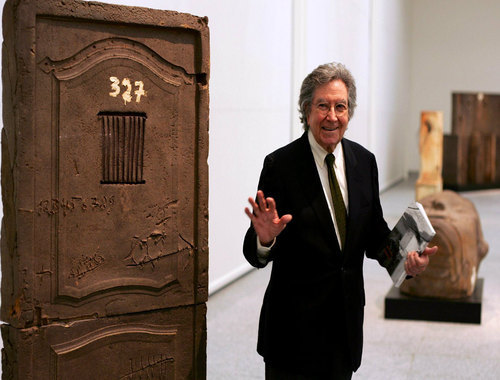Home Page » Post
« Next Article: Barcelona and Madrid among the 20 best cities to study
» Previous Article: Boost Your Career With Spanish
Farewell To An Avantgarde Spirit Antoni Tapies
by Dilek -
Tuesday, February 7, 2012

The Catalan painter and sculptor Antoni Tàpies, one of the leaders of the twentieth century and in particular post-war abstract art, died at the age of 88 in Barcelona. He has suffered from severe health issues lately.
He was born into a family of politicians in 1923 and grew up in the time of turmoil. At 17, Tàpies suffered a near-fatal heart attack caused by tuberculosis. He spent two years as a convalescent in the mountains, reading widely and pursuing an interest in art. The tuberculosis and long stay in the hospital of Puig d'Olena were vital to his training. His readings of Dostoevsky, Wagner auditions or the discovery of Zen philosophy through The Book of Tea, helped him find ways to overcome pain. He studied law for 3 years afterwards he devoted himself only his paintings. With French government scholarship in the early 1950's he lived in Paris.
In 1948, Tàpies was the co-founder - aside from the poet Joan Brossa- of the first Post-War Movement in Spain known as Dau al Set which was connected to the Surrealist and Dadaist Movements. Tàpies started as a surrealist painter, his early works were influenced by Paul Klee and Joan Miró; but soon became an informal artist, working in a style known as pintura matèrica, in which non artistic materials are incorporated into the paintings.
Tàpies' international reputation was well established by the end of the 1950s. From the late 1950s to early 1960s, Tàpies worked with Enrique Tábara, Antonio Saura, Manolo Millares and many other Spanish Informalist artists. During 1970’s (influenced by Pop art) he started merging more authentic objects into his paintings, such as parts of furniture. Tàpies has an important influence on world art, especially in the realms of painting, sculpture, etchings and lithography. Examples of his work are found in numerous major international collections. His work is associated with both Tachisme and Abstract Expressionism. Several exhibitions were held in the prestigious museums and art galeries like Guggenheim Museum in New York.
Antoni Tàpies was a productive artist who experienced all the techniques, painted more than 500 thousand boxes, made about 300 sculptures and graphic production considerably. He wanted to reconcile opposites. The cross or the cross mark, the tension between matter and spirit are the main themes he used. His signs are versatile and always leave a mystery to solve. Its materials are humble, straw, socks, blankets, useful to people, and writing on the walls of the box to the street.
Miguel Angel Munoz, Mexican poet and critic and a good friend of Tápies, says Antoni was an innovator in art for the second half of the twentieth century. "It was Tàpies who reinvented the way to respond to American abstract expressionism."
It was for sure that Tápies, more than a painter or a sculptor, was an art theorist, a special man that caused a change in Europe and Spain, that makes him a cornerstone in the history of art.
Keywords: Spain, Spanish art, painter, catalan, Antoni Tapies
